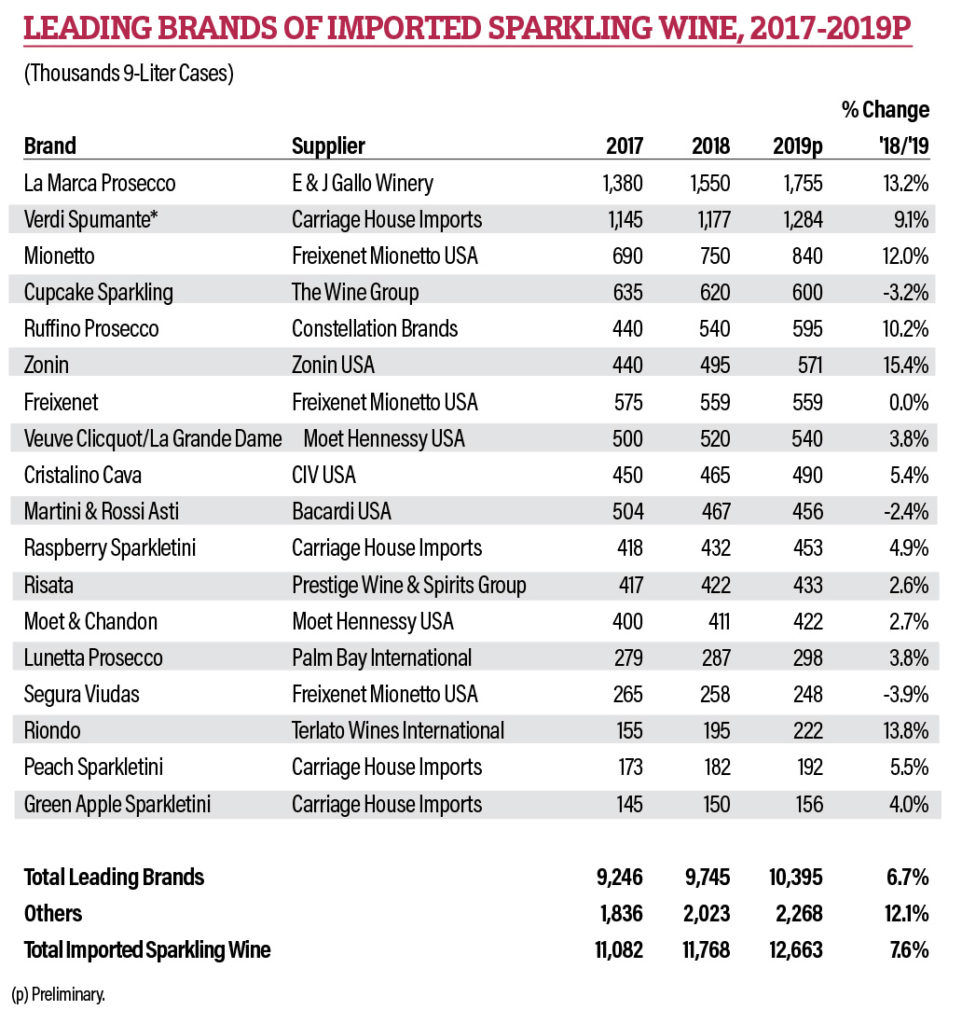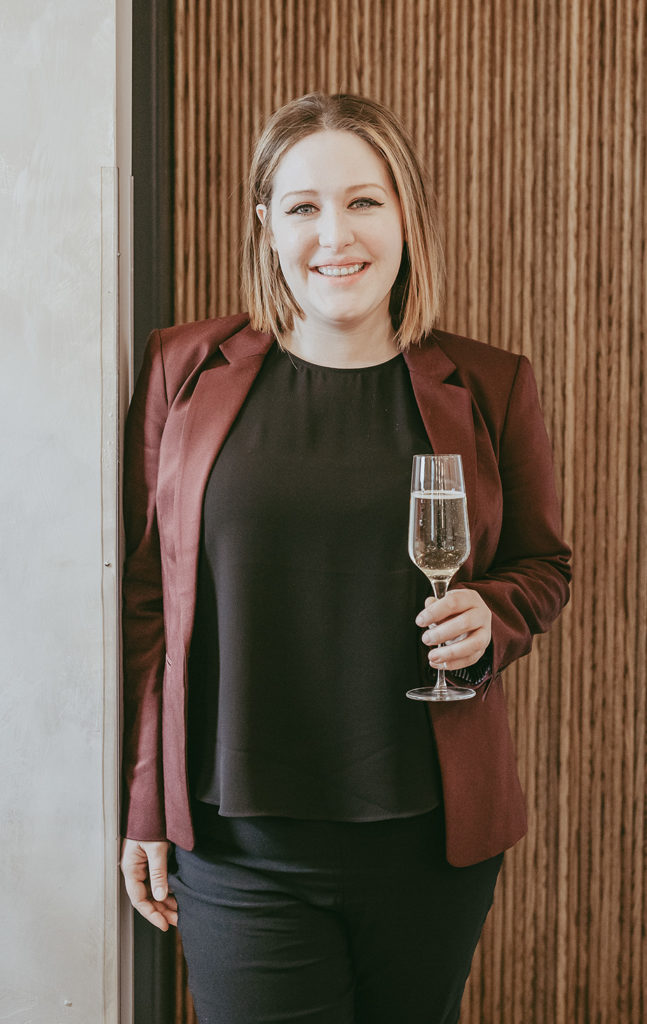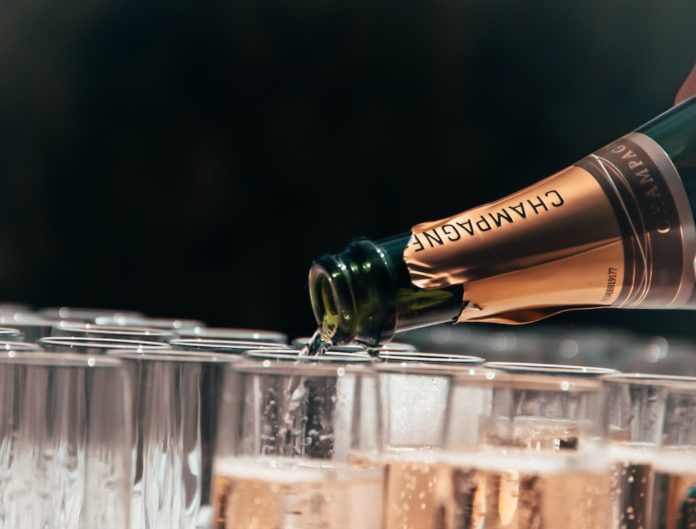Sparkling wine sales are up overall, but preferences vary by style.
Consumers still love the bubbly. Champagne and sparkling wine volume consumption rose about 4% in 2019, according to the Beverage Information and Insights Group, reaching 24.9 million nine-liter cases. That marks the category’s 18th consecutive year of growth since 2002.
The increase was driven by the imported segment, which was up nearly 8%, while domestic sparkling wines fell slightly. Just two brands in the top-10 domestic sparklers posted growth in consumption, #9, Wycliff, with a 16.8% increase in 2019, and #4, Barefoot Bubbly, up 4.3%, both from E. & J. Gallo Winery.
Meanwhile, just two brands in the top-10 imported sparklers posted declines: Cupcake Sparkling, down 3.2%, and Martini & Rossi Asti, which fell 2.4%. The four prosecco brands in the top-10 imports — La Marca, Mionetto, Ruffino and Zonin — all enjoyed double-digit growth in 2019, while cava brand Freixenet was flat with 2018.

While prosecco’s phenomenal growth has slowed, the Italian sparkler’s volume increased 16.5% in the U.S. last year, according to IWSR data. Cava, the Spanish sparkling wine produced in the same method as Champagne, slid 6.9% in 2019, while Champagne volume was up 3.0%, a nod to the continuing trend of consumers trading up and seeking premium brands and beverages.
The coronavirus pandemic may put a pause on that, however. COVID-19 has left more people unemployed, uncertain about the future and perhaps less inclined to spend. Impending additional tariffs on European wines that would include sparklers could also put a crimp in sales.
But sparkling sales have benefitted from a number of trends, including the proliferation of lower-cost and different styles, fun packaging and consumer interest in aperitivo culture and spritz drinks.
France Beyond Champers
French producers outside of the Champagne region make plenty of excellent sparkling wine called crémants. These include Crémant de Bourgogne, Alsace, Loire and Limoux, among others, and are made with the same technique as Champagne but generally use regional grape varietals.
Crémant d’Alsace is “a great value, with special quality,” says Gene Alexeyev, GM/beverage director/sommelier at French brasserie Mintwood Place in Washington D.C. He cites a chardonnay-based option from Camille Braun as a good introduction to French sparkling. Charles De Fere sparkling rosé from Alsace, a slightly off-dry, pinot-noir-based bottling, “is our go-to for celebrations and welcome toasts for regular and VIP guests.”
Limoux in the Languedoc region of southern France is said to be the birthplace of sparkling wine rather than Champagne. Benedictine monks at the Abbaye de Saint Hilaire in 1531 discovered bubbles in a wine that had been bottled and corked.

On the Lambrusco
In addition to prosecco, Italy produces a number of other sparklers. Franciacorta from the north-central Lombardy region is often referred to as Italy’s answer to Champagne, as it’s made using the same method and with similar grapes. Asti (once known as Asti Spumante) and Moscato d’Asti, which is gently bubbled, or frizzante, are sweeter wines from the Piedmont region of northern Italy.
The perception that all Lambrusco is sweet still exists, admits Julia Prestia, owner of Venturini Baldini, which has been making organic Lambrusco and sparkling rosé wines since 1976. But the misconception has been changing, as producers have been using Lambrusco grapes to make dry, fragrant sparkling rosé wines.
“Consumers have been receptive to this new generation of dry premium Lambrusco — a departure from the ‘cheap and cheerful’ sweet fizzy wines that were often served with ice cubes” that tended to define the category in the 1980s, she says.
Tastings are fundamental to changing that perception, Prestia adds. “We spend a lot of time with consumers to let them taste the wines and explore our history; through this they discover Lambrusco as a multifaceted and affordable new wine category.”
Pairings that Pop
Just as more consumers are discovering sparkling wines for everyday occasions, they’re also finding that they pair well with many foods, particularly seafood.
Alexeyev will match the Schramsberg blanc de blancs sparkling wine of 100% chardonnay with meatier seafood such as monkfish or swordfish. Go beyond the “white with fish categorization that seems outdated” and seek out a firm and rich sparkler for heavier dishes, he suggests.

“Oysters, oysters, oysters and any sparkling wine is incredible,” says Brandi Carter, beverage director/sommelier at Elvie’s restaurant in Jackson, MS. “But I’ve been enjoying pairing Szigeti gruner veltliner brut with them recently.” Sparkling rosé with Watermelon Granita “is amazing,” she adds.
Marchese Manodori Reggiano Lambrusco Frizzante from Venturini Baldini pairs well with rich tortellini or barbecued pork. Prestia notes that Venturini Baldini has been popular “in states like Texas and Florida, where our wines are perfect for not just Italian cuisine but also barbeques.”
At Pasta Sisters, an Italian restaurant and fresh pasta shop with locations in the LA area, brand manager Giorgia Sinatra would match the prosecco with the restaurant’s Spaghetti Bottarga (spaghetti with dry Sardinian mullet fish eggs, garlic, extra virgin olive oil), as well as with appetizer plates such as caprese or cold cuts.
Prosecco also pairs well with roasted salmon, she notes. “I would avoid [prosecco with] creamy pastas and meat dishes.”
As for the moscato, the traditional pairing is apricot pie, Sinatra says, “but a very interesting combination could be moscato with a plate of prosciutto and cantaloupe.”
Less is More
Innovation in packaging such as boxes and cans has helped boost wine sales. When it comes to sparkling, alternative bottle formats such as magnums and single-serve mini bottles have been popular.
Champagne brands often opt for flashy packaging. Beau Joie Champagne, with a suggested retail price of $69 to $89, is packaged in a patented bottle encased in copper. The brand has recently seen increased interest because of the notion that copper can destroy bacteria and viruses.
Armand de Brignac Champagne, owned by rap star Jay-Z, comes in metallic gold bottles that start at nearly $200 and is available in several large formats — including a 30-liter “Midas” bottle.
Feature photo by Tristan Gassert on Unsplash.
Melissa Dowling is editor of Cheers magazine, our on-premise sister publication. Read her story, America’s Fastest-Growing Wine Brands.





[…] to progress with lighter extra approachable wines corresponding to Sauvignon Blanc, rose’ and Prosecco. A few of that is more likely to be pushed by the expansion of lighter meals types however it’s […]